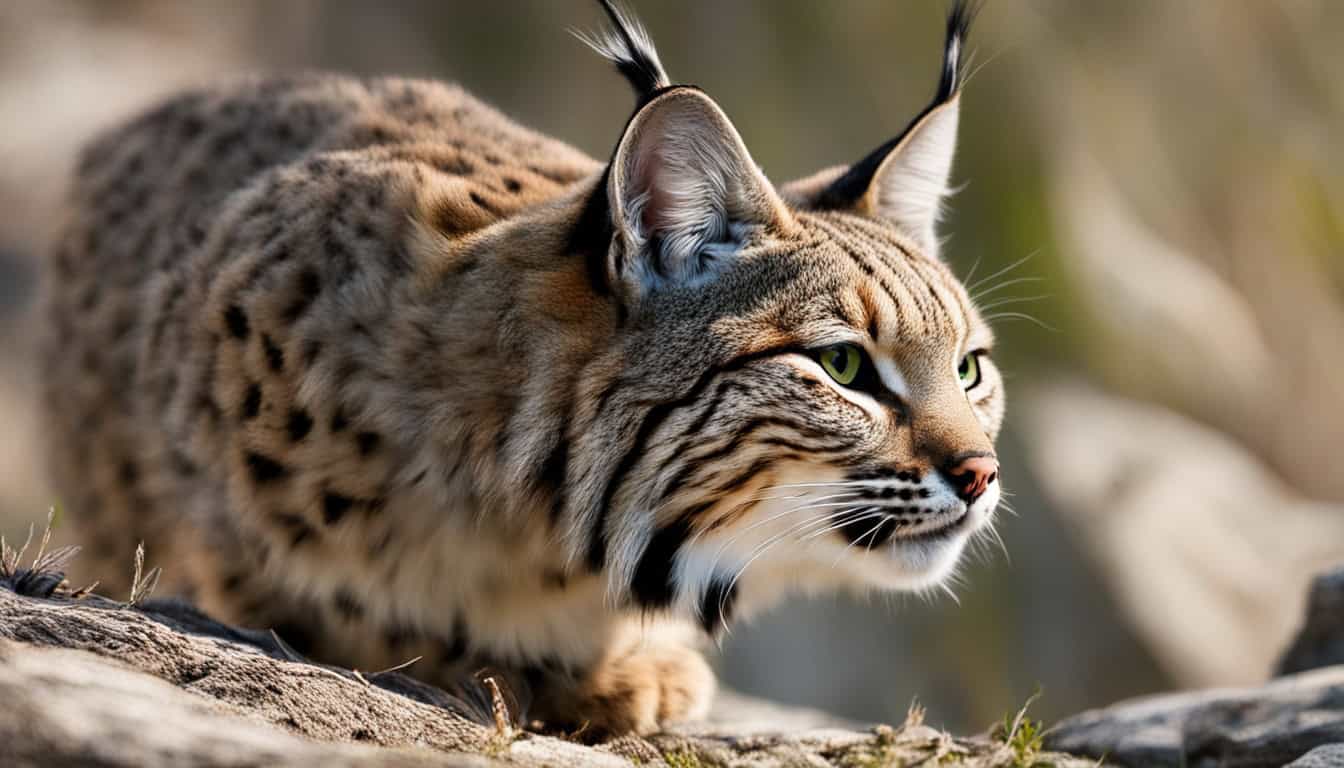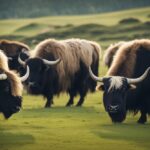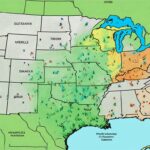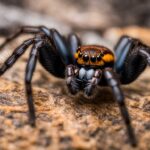The American bobcat is a wild cat known scientifically as Lynx rufus. It is also called the red lynx. This medium-sized cat is found in North America naturally.
Its territory includes southern Canada, most of the U.S., and into Oaxaca, Mexico. This cat is easily recognized by its strong body, spotted coat, and unique short tail.
They live in forests, semi-deserts, suburbs, and swampy areas. Bobcats are very good at adapting to different places. Although they have been hunted a lot in the past, their numbers are holding steady. Yet, they still face dangers like losing their homes and competing with coyotes and pets.
Introduction to the American Bobcat
The American bobcat is a captivating wild cat species. It is known for being very hard to spot and for fitting into every kind of environment well. This cat helps keep nature in balance by hunting other animals in its area.
Bobcats are special because of their spotted fur. This helps them hide so well. They have amazing eyes and ears that make them great at finding and catching their prey.
Bobcats live alone and guard the areas they claim. They do this by using scent and leaving marks. This way, they make sure they have what they need to live where they do. Bobcats can live in many places in North America, from big forests to cities.
| Key Adaptations | Description |
|---|---|
| Dappled Coat | Helps hide in different places |
| Keen Senses | Strong eyes and ears for hunting |
| Territorial Instincts | Mark territories for resources and safety |
The bobcat’s blend of looks and actions show what a tough and flexible hunter it is. Studying the American bobcat can teach us about how healthy our nature is. It reminds us why we should work to protect this amazing cat.
Understanding American Bobcat Habitat
The American bobcat thrives in many places, showing how well it can adjust. They can live in a range of habitats, proving their adaptability. This makes them truly versatile in nature.
Woodlands and Forests
They often live in thick woodlands and large forest areas. Bobcats use their skill at hiding and hunting to move around easily. In these places, their food and the animals that might eat them are in a good balance. This balance helps bobcats live and have babies successfully.
Semi-Deserts and Swamplands
American bobcats also live in dry semi-deserts and the edges of wet swamplands. These areas provide different challenges. They allow the bobcat to handle varying amounts of water and types of land. The bobcat’s success in these different places proves how diverse its habitats are.
Urban and Edge Environments
Bobcats are even found on the outskirts of cities and towns. They have adapted to live close to people’s living spaces. This shows their strong ability to deal with living near humans. Urban areas, which continue to grow, don’t seem to bother them much.
| Habitat Type | Characteristics | Adaptation Tactics |
|---|---|---|
| Woodlands and Forests | Dense trees, rich flora, abundant prey | Camouflage, stealth hunting |
| Semi-Deserts and Swamplands | Arid conditions, varied terrain | Water conservation, terrain navigation |
| Urban and Edge Environments | Proximity to human activity | Adapted for coexistence with urban wildlife |
Geographic Range of the American Bobcat
The American bobcat covers a large area in North America. It ranges from the south of Canada to the north of Mexico. This shows how well it can live and thrive in different places.
Southern Canada to Northern Mexico
Bobcats live in a variety of places from Canada’s north to Mexico’s south. This range proves their ability to adapt to different ecosystems and climates. It’s amazing how they have spread so well across the continent.
Variations from East to West
Looking from east to west, we see bobcats making the most of their homes. The eastern parts have dense forests while the western areas are semi-deserts. Bobcats change to fit these different places by adjusting how they look and what they do.
Regional Adaptations
Bobcats are true survivors, adapting to diverse surroundings. In cold spots, they grow thicker fur to stay warm. But in the south, they wear lighter coats. These changes in fur show how they cope with various weather and habitats.
| Region | Habitat Type | Adaptations |
|---|---|---|
| Southern Canada | Forested wilderness | Thicker fur for colder climates |
| United States (Eastern) | Dense woodlands | Camouflage dappled coat |
| United States (Western) | Semi-deserts | Efficient water retention, lighter fur |
| Northern Mexico | Scrublands | Adaptability to heat, lighter coat |
What is the range of the American bobcat?
The American bobcat can be found across many North American places. These include Canada’s dense forests to Mexico’s rugged landscapes. They show that they can live in different climates and terrains.
Their territorial span tells us they are good at finding their way around all kinds of lands. They mainly choose where to live based on food. The weather and land also affect their choices, making them live in busy or quiet places.
Looking closer at North American ecosystems, we see how bobcats find a place to call home. They pick areas to live based on how much food is there. This ability makes sure there are enough bobcats in many places.
| Region | Typical Habitat | Key Adaptations |
|---|---|---|
| Canada | Coniferous Forests | Thicker Fur for Cold Climates |
| United States | Mixed Woodlands, Swamplands, Urban Edges | Camouflage, Stealthy Hunting Techniques |
| Mexico | Scrublands | Heat Tolerance, Efficient Water Use |
By studying their range, we learn about where these strong hunters live and how they survive. The American bobcat’s ability to handle different environments and deal with people shows why they do well in many places.
Factors Influencing Bobcat Distribution
American bobcats choose their homes based on many reasons. These include the availability of prey and how they adapt to living near people. It’s vital for us to understand these factors to help manage and protect them.
Availability of Prey
What bobcats eat affects where they live. They love hunting rabbits, hares, and rodents. If these animals are plenty, bobcats will stay in one place. If not, they might look for food elsewhere. This explains why you find more of them in some areas than others.
Human Activity and Adaptation
The way we live can change bobcats’ homes too. Cities and farms sometimes break up their natural spaces. But, bobcats can be surprisingly flexible. They choose to live near towns and use farmlands to find food. This shows how well they can adapt to a changing world.
Population Distribution Across North America
Bobcat populations in North America are doing well, especially in the United States and Canada. This success is due to good wildlife management and protecting their habitat. But, the number of bobcats you find can depend on where you are because of varying environmental factors.
Stable Populations in United States and Canada
In the U.S. and Canada, bobcats are thriving. Thanks to lots of wild areas and rules to protect them, bobcats have a good chance. These areas help keep the number of bobcats steady, which is important for their future.
Regional Differences in Density
Differences in how many bobcats you see are based on the land and what they can eat. For instance, bigger bobcats live in eastern Canada and the western U.S., while Mexican bobcats are smaller. These changes show bobcats can find a way to live well all around North America.
American Bobcat Territory and Home Range
The bobcat home range size and territorial behavior vary a lot. Bobcats use scent and signs to show their territory, telling other bobcats to stay away.
In places with lots of prey, bobcats have smaller territories. This lets them live in dense forests full of food. But in dry areas without much to eat, bobcats need bigger areas. They do this to find enough food. This shows how nature changes bobcats’ territories to fit their needs.
Male and female bobcats also differ in the size of their territories. Males have larger territories to find mates. The type of land affects this too. Mountain bobcats and plain bobcats might have very different territories.
| Factor | Impact on Home Range |
|---|---|
| Prey Abundance | Smaller home ranges with plentiful prey |
| Arid Landscapes | Larger home ranges due to scarce resources |
| Gender | Males have larger territories than females |
| Geographical Area | Regional variations in wildlife territory dynamics |
Learning about bobcats can teach us a lot. It helps us see how they survive in many places in North America. We also learn what affects where they live.
The Impact of Climate and Geography on Bobcat Range
It’s key to see how the climate affects bobcats to understand them better. Weather changes what food is available and when bobcats move and have babies. In cold places, bobcats might have to search further for food in winter.
Mountains and plains form natural borders that affect where bobcats live.
Places with different land types make bobcats adjust how they hunt and move. Rivers and mountains stop bobcats from going everywhere, helping shape where they live. They show they can do well in tough and easy places.

Looking at how climate and land impacts bobcats shows they can change. Understanding how climate, land, and habitat affect bobcats helps see how they survive and spread across North America.
| Region | Climate Impact | Geographical Impact |
|---|---|---|
| Northern Canada | Severe winters limit prey availability, extending ranges | Mountains restrict movement; large territories |
| Western US | Arid climates require adaptation to scarce water | Rocky terrains create pockets of isolated habitats |
| Southeastern US | Warm, humid climates provide abundant prey year-round | Swamplands and forests influence dense population clusters |
Climate and land together show how well bobcats do in different places. They are amazing at making the best of their surroundings.
Conservation Status and Threats
Currently, the American bobcat is labeled as Least Concern on the IUCN Red List. Yet, there are challenges. These could change the bobcat’s status in the future.
Legal Protections
Many places have set laws to protect bobcats from being hunted or trapped too much. These rules aim to keep bobcat numbers stable against growing threats. It’s key to make sure these laws are followed well. This helps prevent a drop in bobcat populations.
Human Impact and Habitat Loss
Habitat loss due to more cities and farms is a big threat to bobcats. This pushes them to live in smaller, disconnected areas. This change affects their way of life and how well they can survive.
Hunting and Trapping
Hunting and trapping are controlled but still harmful. Too much hunting in some places can lower bobcat numbers locally. This shows why laws and ways of trapping must be checked and updated often. Such efforts help in keeping bobcat populations healthy.
| Threat | Impact |
|---|---|
| Habitat Loss | Fragmented habitats affected bobcat behavior and population stability. |
| Human Activity | Urbanization and agricultural practices encroach natural bobcat territories. |
| Hunting and Trapping | Risk of overharvesting emphasizes the need for sustainable practices. |
| Legal Protections | Enforcement of laws is crucial to maintain population levels. |
Bobcat Population Trends and Research
It’s vital to track bobcat numbers to see how the world around them changes. We now use high-tech tools like GPS collars and camera traps to learn more about them. This tech lets us understand where they go and what they do, helping in their conservation.
Recent studies show why we need to keep an eye on bobcats. To do this, researchers track them with GPS to see their territories. This helps us predict how their populations might change due to things like the climate getting warmer or their homes getting smaller.
Studying bobcats also helps us better manage their populations. Cameras catch bobcats in action and also show if they are too close to people. This information is crucial for keeping bobcats safe and ensuring they stay a key part of North America’s wildlife.
FAQ
What is the range of the American bobcat?
The American bobcat lives from southern Canada through most of the United States. It then goes all the way to Oaxaca, Mexico. They show they can live in a lot of places in North America. This is because they can fit well into different environments.
What kind of habitats do American bobcats prefer?
American bobcats live in all kinds of places. They are seen in thick woods, large forests, and dry semi-deserts. They also live in swamps and near cities. These cats do well where there is enough cover and food.
How do American bobcats adapt to their environments?
Bobcats have special traits that help them survive. They have a spotted coat for hiding, sharp senses for hunting, and they mark their territory. Because of these adaptations, they can live in many different places. From the cold forests of Canada to the hot scrublands of Mexico.
How does human activity impact bobcat distribution?
Humans building cities and farms are changing bobcats’ homes. Sometimes, bobcats and people do not get along. But, bobcats show they can live near humans. They are good at finding ways to keep on living, even with these changes.
What is the current population status of American bobcats?
Bobcat numbers are steady in the United States and Canada. This is because of good wildlife management and lots of places for them to live. Yet, they still struggle with losing their homes and having to share space with other animals.
How large is the typical territory of an American bobcat?
The space a bobcat needs can vary a lot. It depends on where they live, how much food there is, and if they are male or female. Males usually need more space than females. They could make their territory in thick woods or open dry lands.
How do climate and geography influence bobcat behavior?
The climate and landscape really change how bobcats act and where they live. The weather affects what they hunt and eat. The land, like mountains and fields, decides their living space and where they find food. These things help bobcats do well in many places.
What legal protections exist for American bobcats?
There are rules to protect bobcats from being killed too much. Right now, they are not seen as in big danger on the world’s animal danger list. But, it’s still important to keep watching them and making sure they are safe from losing their homes and other dangers.
What research methods are used to monitor bobcat populations?
Scientists use new tools like GPS collars and hidden cameras to see how bobcats live. This helps them learn more about the cats’ lives. It also helps make plans to keep the bobcats’ numbers from going down, even with changes in their environment.







